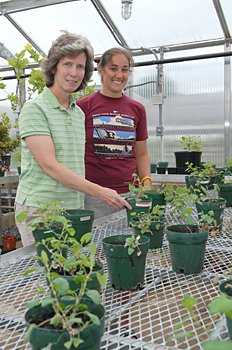
Paras is working with Judy Hough-Goldstein, a UD professor of entomology who has spearheaded a number of groundbreaking research projects into the biological control of invasive plants.
Invasive plants are nonindigenous species that spread on their own through forests, wetlands, meadows, by roadsides and in parks and backyards. Some invasives reach high densities and create economic and/or environmental damage. The invasive plant that has probably received the most notoriety is kudzu, which now covers more than 7 million acres in the South and also is found in Delaware.
Invasive plants typically have a number of characteristics that help them increase quickly, including early maturation and copious reproduction by seeds. Another important factor is the fact that invasive plants are usually free of attack by the local population of insects, as many native insects only eat native plants.
And that's where Hough-Goldstein comes into the picture. She and her team of undergraduate and graduate researchers release non-native insects into plots of invasive plants, track the dispersal and establishment of these insects, and evaluate how much feeding damage occurs. In the case of mile-a-minute, the non-native insect released is Rhinoncomimus latipes Korotyaev, a stem-boring insect that, like mile-a-minute, is native to China. This insect is host-specific to mile-a-minute; in other words, it won't eat any other plant.
This summer, Paras is responsible for a research plot on the UD Farm, one of several plots that the team has established in the Mid-Atlantic region. When she helps monitor release sites, she sets out for the field with clipboard in hand to tally the number of adult weevils and weevil eggs and to assess the percentage of feeding damage to each plant. The feeding holes are relatively easy to see; they're called “shot holes” because they look like tiny shotgun blasts arranged in close proximity on a target.
At other times of the day, Paras can be found in the South Greenhouse, tending mile-a-minute plants that will be used for future study, or back in the laboratory, evaluating data. She is participating as a Science and Engineering Scholar, which is an in-depth research apprenticeship offered to select students after their sophomore year. Last summer, Paras's role as lab assistant was funded through the project grant. She works closely not only with Hough-Goldstein but also with graduate student Ellen Lake, who has been involved in the research since 2004.
“It was pretty incredible to be given this opportunity to do research after my freshman year,” Paras said. “I'm learning so much about the scientific process and about working with others in a scientific community.”
The groundwork for these test plots was laid long before Paras--or even Lake--joined the research team. Hough-Goldstein, as well as collaborators in China, conducted years of laboratory testing before any field work could be carried out. This early work, as well as the current field research, has been funded by the U.S. Forest Service.
“I first starting evaluating Rhinoncomimus latipes Korotyaev as a potential biological control in 1996,” Hough-Goldstein said. “These tests were run in strict quarantine conditions--the USDA-ARS quarantine lab that we used features a state-of-the-art ventilation system, triple-insulated windows and every other possible precaution.
“By 2003, I was ready to apply for a federal permit for the insect release, which I received in July 2004. And by August of that year, we had conducted our first release.”
Hough-Goldstein was the first researcher in the world to test and obtain a permit to release a biological control agent of mile-a-minute weed. Today, her lab is still the only one in the U.S.--and one of a handful in the world--attempting to control this invasive plant through biological means.
Although only three seasons of data have been collected thus far, preliminary findings are encouraging. The first releases suggest that Rhinoncomimus latipes Korotyaev establishes easily, produces multiple generations per year and that adult feeding on small plants can kill mile-a-minute plants.
What remains to be seen, Hough-Goldstein said, is whether insect populations will develop in high enough numbers to significantly impact the survival, seed production and spread of the mile-a-minute plant.
To gather more data to help answer that question, Hough-Goldstein will soon add another site to the study--a plot of land on Pea Patch Island, which is located in the Delaware River, facing Delaware City.
“Pea Patch is covered with mile-a-minute, but control of the weed has been especially problematic there,” Hough-Goldstein said. “The island is home to the largest heronry north of Florida on the East Coast. Herbicides can't be used because of the possible impact on the thousands of herons, egrets and ibises residing there.”
Currently, the research team is working in conjunction with state officials to assess the site and determine where to place quadrants and release weevils for the latest mile-a-minute project site.
Article by Margo McDonough
Photo by Danielle Quigley


